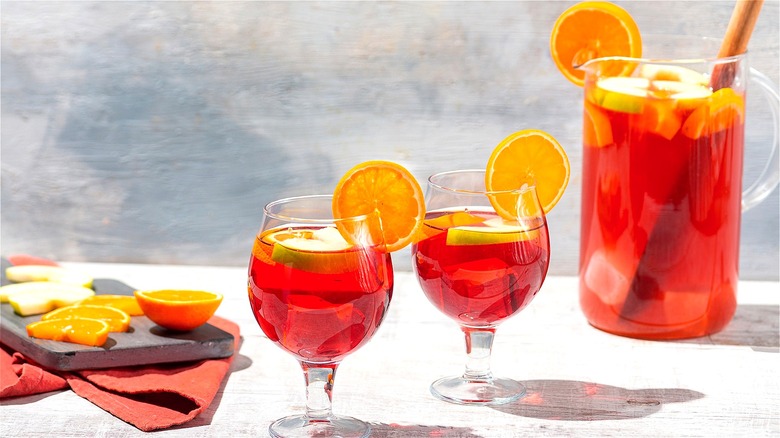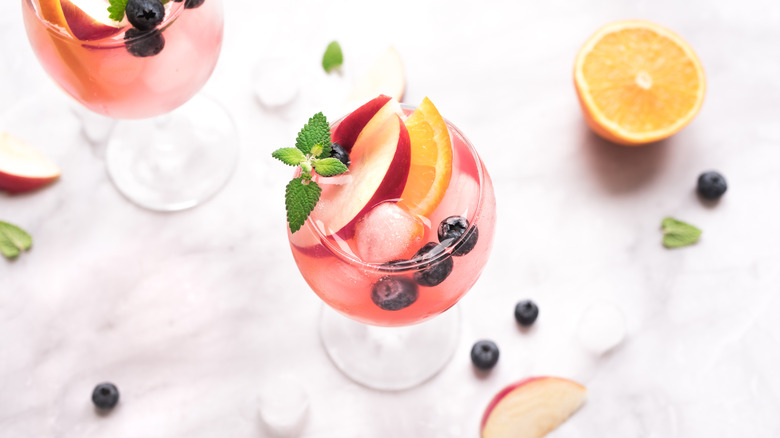The Best Types Of Wine To Pick For Delicious Sangria
Next to margaritas, mojitos, and other refreshing cocktails, sangria is the perfect drink to enjoy on warm sunny days (and dreary days, too). This colorful Spanish cocktail is primarily composed of either red or white wine and contains extra ingredients like sparkling water, fresh fruit, and special liqueurs for added flavor. Since sangria is often loaded with additional spirits and fresh sweet produce, choosing the right wine for the culturally rich drink is essential.
If you want a sangria that shines, pick a red wine with fewer tannins, which are naturally occurring plant compounds that impart a slightly bitter, harsh taste to your tongue. Pinot Noir, Zinfandel, and any red medium-bodied varieties from Spain such as malbec and grenache are all solid options. If you're having difficulty choosing, stick to an easy-to-drink red blend. An even-flavored, well-rounded wine won't steal the show from the extra ingredients added to your homemade sangria.
Alternatively, if you fancy white wine sangria, albariño varieties from Spain and torrontés from Argentina are solid choices. Both varieties are easy to drink, and each has a tropical, light body that pairs well with fresh fruit and exciting mix-ins like Grand Marnier and seltzer. Common everyday options include chenin blanc or pinot grigio. Whether you're choosing red or white wine for your next pitcher of sangria, stick to varieties that aren't too sweet, pair well with many different foods, and are, most importantly, enjoyable to drink.
What about sparkling wine and rosé?
Before you run off to your kitchen to make the perfect sangria, choose your wine variety wisely. Sure enough, rosé can also be transformed into your favorite wine-based cocktail as long as you're following the same selection protocol. Instead of using your favorite dry rosé, select a medium-bodied rosado from either Spain or California. Rosado has a subtly fruity essence that combines perfectly with fresh fruit and added spirits like triple sec and Cointreau. You can also try a grenache rosé which has a crisp yet clean flavor profile reminiscent of orange, strawberry, and hibiscus. The fun part about using rosé has everything to do with the color. Instead of adding the usual apples and oranges, lean into that alluring pink hue and opt for strawberries and raspberries.
In addition to making rosé-infused sangria and rosé sangria punch, you can skip the added sparkling water or seltzer in your fruity cocktail by choosing a sparkling wine from the start. Cava, essentially the Spanish version of champagne, is a great sangria base when you desire an extra bubbly yet crisp bite. Cava also has distinct qualities of fine champagne but costs less. The flavor profile of Cava ranges in dryness but maintains an acidic, citrusy taste that combines perfectly with the drink's added fruits. As long as drinkability stays at the forefront of your mind, many different wines can be made into refreshing sangria. Still, not every bottle will work.
Wine varieties to avoid when making sangria at home
If you're new to sangria, a key component in producing a stand-out pitcher is ensuring your ingredients shine on their own accord and don't become overpowered by your wine of choice. This may be tricky if you have a taste for fine wines with robust flavor profiles and age-based specifications.
Even if you typically gravitate towards bold reds, you'll want to skip the cabernet sauvignon and syrah. These hearty varieties often have intense flavor profiles that don't readily transform into easy-to-drink sangria.
When it comes to white wine varieties, steer clear of aged chardonnays, sweet sherry, and Madiera. For the best citrusy white sangria recipe, choose a wine that isn't too intense in flavor and doesn't contain overly sweet undertones. However, if you want to avoid using fruit juice, you can certainly opt for a sweeter white variety like riesling or Moscato.
All in all, save your precious dollars by avoiding super-expensive bottles of wine. Especially when bold and flavorful additions like brandy, triple sec, and fruit juice are added to the mix, you want a wine variety that sits comfortably at the forefront without dominating your sangria's entire flavor. Since this wine-infused beverage is often enjoyed chilled on warm sunny days, aim to make your next pitch of sangria refreshing and easily consumable.


